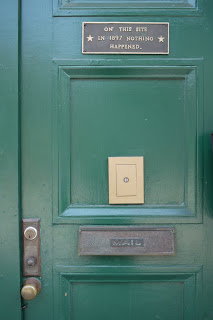Thursday, December 30, 2010
sophistication requires receptivity
Sunday, October 31, 2010
Plus ça change...

Sunday, October 17, 2010
I was there

 Ai Weiwei's Sunflower Seeds at Tate Modern, photo from The Daily Mail
Ai Weiwei's Sunflower Seeds at Tate Modern, photo from The Daily Mail
Sitting on the floor on the Turbine Hall at the Tate Modern last week I felt overwhelmed. Ai Weiwei's new installation, Sunflower Seeds, part of the Tate's Unilever Series, features millions of hand-painted, hand-crafted porcelain sunflower seeds. The artist's intentions for the work are multi-faceted and wide-ranging, from communism and mass-production. Though these ideas are certainly communicated, Weiwei's original vision for the project conveys a more hopeful, positive sensation than these topics might suggest. My view was the photo on top as I sat amidst these myriad seeds. Like sand, they conformed to my weight, comfortable but not forgettable. Around me, people were sitting, standing, laying, walking, generally interacting with the artwork(s). This was Weiwei's desire and the result was communal, peaceful, a breakdown of that art/audience barrier. Circumstances beyond his control, however, have ensured that going forward the bottom photo will be the public's view. I fear that the heavier messages of the work will inevitably overshadow the hope that was intended: go see it, but remember this. In the end, this is one of the rare instances I am proud to say 'I was there,' and, hey, how did that seed get in my pocket? ;)
Thursday, August 19, 2010
Wednesday, July 21, 2010
détruit
Today I have considered the notion of the destruction of artworks. Many of the artists with whom I have become intimate have several, if not a great many, paintings or sculptures which they themselves chose to destroy. Happily, some remnants survive in sketch form or are described by contemporary critics but this is not always the case. Common reasons cited for committing such acts include a complete stylistic shift, scathing reviews in the press, or random bouts of fury. This is a mentality I cannot grasp. Why would someone want to obliterate their past? Perhaps I am too sentimental; perhaps they were without hope of better days to come in which they could look back and see their lives' progression.
Over a century and a half later these works have been forgotten while other pieces -pastels, maquettes, sketches - live on in gilded frames on hallowed walls. Would my dear artists consider this a success? Would they regret their past destruction seeing now how it could have added to our modern understanding? Would they embrace modern, temporary art which is designed to eventually disappear?
Monday, July 12, 2010
the value of art
Wednesday, July 7, 2010
out-courbeted
Friday, July 2, 2010
you and your space



Tuesday, June 29, 2010
a disappointment
As is well-known within the art community, this fabulous painting by Edouard Manet was sold at auction recently. The price tag far exceeded other paintings of his that have heard the hammer in the past but it still lagged far behind other artists like Matisse and Picasso. I do not begrudge the latter artists their respective fame and I certainly acknowledge their talent and influence. The response of the press, however, to this rare self-portrait has been upsetting at best. The New York Times noted that it was too intellectual to have the appeal of other artists and quoted a dealer to have said it "put a damper on the evening." The BBC quoted an Art Journalist who, when explaining the lack of interest in the work, said that it appeared too much like the work of an 'Old Master.' Though I realise the majority of the world's interest is not captivated by Manet in the same way mine is, I feel that ignorance permeates these articles and the writers would have done well to attempt to explain these standpoints, and perhaps give a bit of context instead of wowing readers with dollar signs.
Sunday, June 27, 2010
nationhood
The Enlightenment of the late eighteenth century structured many of our current patterns of thought, some obviously, some less so. One of the larger, more frequently discussed shifts, with regards to Western Europe, was a stronger focus on science, which meant a step away from a unified, organised religion. While reading Benedict Anderson’s Imagined Communities I engaged with his thoughts on this, though it was not his over-arching point and I am surely over-simplifying. Religion addressed many of the bigger questions for people, including the purpose of death. Without religion, this question remained. In its place the pluralism found in Nationalism was promoted, a new concept or cause to which one could devote one’s self, living and dying. He rightfully notes that Nationalism is a presupposed frame of reference now much as dynasties and religion were in the not-too-distant past.






